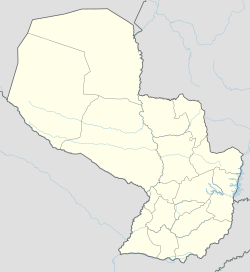San Pedro de Ycuamandiyú facts for kids
Quick facts for kids
San Pedro de Ycuamandyyú
|
||
|---|---|---|
|
City and district
|
||
 |
||
|
||
| Country | Paraguay | |
| Department | San Pedro | |
| Founded | 16 March 1786 by Commander José Ferreira and Captain Pedro García | |
| Area | ||
| • Total | 3,185 km2 (1,230 sq mi) | |
| Elevation | 64 m (210 ft) | |
| Population
(2008)
|
||
| • Total | 32,918 | |
| • Density | 9/km2 (20/sq mi) | |
| Time zone | -4 Gmt | |
| Postal code |
8000
|
|
| Area code(s) | (595) (342) | |
San Pedro de Ycuamandyyú is a city and district in Paraguay. It is the capital of the San Pedro Department.
A long time ago, in 1524, a European explorer named Aleixo Garcia traveled through Paraguay. He was the first European to reach the Inca empire. People believe he was killed near San Pedro when he was returning home.
Contents
What's in a Name? The Story of San Pedro
The original name of the city was "Villa de San Pedro Apóstol de ykuaminday." This long name has a special meaning!
In the Guaraní language, "ykua" means "water source" and "mandyju" means "cotton." So, the name means "San Pedro's village from the water source of the cotton field." There was a cotton plant growing near a well.
In 1786, Governor Pedro Melo de Portugal sent Captain Pedro García to start a small village in this area.
Where is San Pedro?
San Pedro de Ycuamandyyú is located in Paraguay. Route XI "Juana de Lara" connects the city to Route III "Elizardo Aquino" to the east.
The city is about 25 kilometers (15 miles) from the Paraguay River. It is also 15 kilometers (9 miles) from Antequera district and only 3 kilometers (2 miles) from the Jejui River.
Weather in San Pedro
The weather in San Pedro is usually humid and rainy. The air often feels moist, with humidity between 70% and 80%.
The average temperature is around 23 °C (73 °F). In summer, it can get as hot as 35 °C (95 °F). In winter, the temperature can drop to 10 °C (50 °F).
| Climate data for San Pedro de Ycuamandiyú (1991–2020) | |||||||||||||
|---|---|---|---|---|---|---|---|---|---|---|---|---|---|
| Month | Jan | Feb | Mar | Apr | May | Jun | Jul | Aug | Sep | Oct | Nov | Dec | Year |
| Mean daily maximum °C (°F) | 34.2 (93.6) |
33.2 (91.8) |
31.9 (89.4) |
29.0 (84.2) |
24.9 (76.8) |
23.5 (74.3) |
23.8 (74.8) |
26.7 (80.1) |
28.7 (83.7) |
31.0 (87.8) |
31.8 (89.2) |
33.3 (91.9) |
29.3 (84.7) |
| Daily mean °C (°F) | 27.2 (81.0) |
26.7 (80.1) |
25.5 (77.9) |
23.2 (73.8) |
19.5 (67.1) |
18.5 (65.3) |
17.5 (63.5) |
19.5 (67.1) |
21.4 (70.5) |
24.2 (75.6) |
25.0 (77.0) |
26.7 (80.1) |
22.9 (73.2) |
| Mean daily minimum °C (°F) | 22.7 (72.9) |
22.3 (72.1) |
21.1 (70.0) |
18.7 (65.7) |
15.3 (59.5) |
14.2 (57.6) |
12.7 (54.9) |
14.1 (57.4) |
16.2 (61.2) |
19.5 (67.1) |
20.1 (68.2) |
21.9 (71.4) |
18.2 (64.8) |
| Average precipitation mm (inches) | 139.7 (5.50) |
179.4 (7.06) |
100.3 (3.95) |
153.1 (6.03) |
140.2 (5.52) |
81.6 (3.21) |
58.5 (2.30) |
39.2 (1.54) |
88.3 (3.48) |
164.5 (6.48) |
187.9 (7.40) |
161.9 (6.37) |
1,494.6 (58.84) |
| Source: NOAA | |||||||||||||
Who Lives in San Pedro?
San Pedro has about 29,097 people living there. Out of these, 15,043 are men and 14,054 are women.
Most people, about 21,170, live in the countryside areas. Around 7,927 people live in the city itself.
A Look Back: San Pedro's History
San Pedro was officially founded on March 16, 1786. It was started by Commander José Ferreira and Captain Pedro García.
How San Pedro Makes a Living
The main way people in San Pedro make money is through raising cattle. This means they raise cows and other animals.
Farmers also grow many different crops. These include yerba mate, cotton, soy, beans, potatoes, alfalfa, citrus fruits, peanuts, manioc, and wheat.
Some industries in the area work with wood, oil, and petit grain (an oil from citrus trees). Local people also create beautiful handmade items. They make embroidered cloth called ao poi and clay artwork.
Things to See and Do in San Pedro
San Pedro is known as the "Capital of Cordiality." This is because the people are very friendly and welcoming to visitors.
One of the best things to see are the old, colorful houses. They show what buildings looked like during the colonial period.
The city's church is also very important. It was built when Don Carlos Antonio López was in charge. It has been rebuilt to keep its original look. The altar and the statues inside are valuable pieces of Paraguayan history.
You can also visit Mr. Francisco Resquin's museum. It has many important historical items from the region.
The Casa de la Cultura (House of Culture) is another interesting place. Local artists show their work here. You can also find poetry readings, guitar lessons, and music classes.
For outdoor fun, the Jejui River has nice shores and a beach. It's a great spot for people to go camping.
See also
 In Spanish: San Pedro de Ycuamandiyú para niños
In Spanish: San Pedro de Ycuamandiyú para niños




